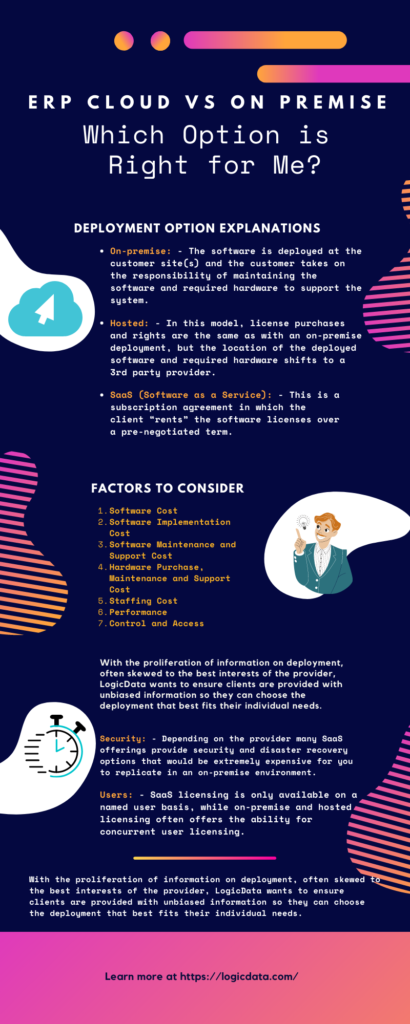

An ERP system can primarily be deployed in 3 different ways, on-premise, hosted or by subscription. Each of these deployment options provides certain benefits and possible drawbacks, depending on the client’s business environment and requirements. There is a large amount of information available regarding deployment, but it is often conflicting and doesn’t take into consideration specific client requirements. In the hope of clarifying what can often be a confusing customer decision, LogicData has compiled the following to help you determine the deployment option that best fits your needs.
In addition to the 3 primary deployment methods listed below, it is important to note that there are additional deployment methodologies that may represent a hybrid approach, combining one or more of the below options, especially when the client requirements call for additional software solutions from multiple providers. Also note that not all providers offer all deployment options.
As the name implies, with this option, the software is deployed at the customer site(s) and the customer takes on the responsibility of maintaining the software and required hardware to support the system. Generally, the customer pays for, or finances, all software at time of purchase and retains the right to use the licenses in perpetuity.
In this model, license purchases and rights are the same as with an on-premise deployment, but the location of the deployed software and required hardware shifts to a 3rd party provider. There are two distinct paths in this scenario. The client can choose a 3rd party provider who provides only for the hardware requirements, in which case the responsibility for maintaining the software still resides with the client, or the client can choose a provider that will maintain both the hardware and the software.
This is a subscription agreement in which the client “rents” the software licenses over a pre-negotiated term. The client maintains the right to utilize the software as long as subscription fees are paid. Generally, the client pays for the use of the licenses on an annual basis over the course of the term. Additionally, as part of the service, the software provider, or their contracted partner, maintains and supports the software and hardware. Depending on provider and software configuration, the client’s instance can reside either in a single-tenant or multi-tenant environment.
The most common type of SaaS deployment. Your software and data reside in a shared environment with other companies (tenants). Updates to the software thus affect all the tenants. For security purposes, none of the tenants are allowed to access the database server or environment in any way other than what is provided by the user facing interface of the software. Because a single environment is shared across multiple companies, the cost of overhead for the SaaS provider is lowered and thus your cost per user is less expensive.
Not a common option and may not be offered by many providers. In a Single-tenant deployment your software and data resides on an isolated set of servers that only serve your company. In a sense this is very similar to running the software on-premises or through a hosting service, except that you don’t own the software. Because you are isolated from other companies, you have a higher level of access to the back-end environment. You may also have the privilege of saying what updates can be installed and when. Because of the higher overhead (dedicated servers and software) Single-Tenant SaaS carries a significantly higher price tag.
There are many factors that determine which deployment method will be the most beneficial to the individual client. The client must determine which criteria are most important in choosing a deployment option. Some of the more frequent, and generally important considerations are discussed below.
Generally, SaaS is the most cost-effective option from a software perspective when considering the short term. However, usually within the 3rd full year of deployment, an on-premise model becomes more cost effective from a software standpoint, even when considering ongoing software maintenance and support costs.
Deployment choice has very little impact on implementation cost. Regardless of deployment, the solution still needs to be implemented through training, piloting and process engineering for your specific environment. The only variance in cost between SaaS and an on-premise or hosted environment are installation costs, which generally do not apply in a SaaS deployment. Installation costs are generally less than 5% of overall implementation costs.
Generally, these annual costs are included with a SaaS subscription, while they are separate costs in an on-premise or hosted deployment. These costs vary by provider and software purchased, but as mentioned above, even when added to the original software cost of an on-premise or hosted model, are generally offset in the TOC (Total Cost of Ownership) within 3 to 4 years of deployment.
These costs must be considered in an on-premise deployment while they are not relevant in a SaaS or hosted deployment. Depending on your specific situation, the necessary infrastructure may already be in place with little to no additional investment necessary. However, when combined with possible staffing costs, if you do not have the necessary infrastructure in place, SaaS or Hosting may become the most beneficial option. Hardware requirements will vary by system and configuration, but it is likely that at least an additional 1 to 2 servers and associated storage may be required.
This cost can be analyzed just as the above Hardware costs. In a SaaS environment the responsibility for maintaining the system resides with the software provider. This is also the same in a fully hosted environment. However, in an on-premise deployment, or in a hosting scenario where the client is only leasing server space, you need to insure proper staffing and expertise to maintain the system. Again, if you already employ a competent IT staff, there may be little to no additional investment necessary. Maintenance and support time will vary, but it is realistic to expect devoting at least 10-20 hours a month to maintenance and support requirements.
In today’s environment performance based on deployment option should not be much of a consideration although there may still be variances between providers chosen. Rather than deployment option, performance consideration should center around geography: the further away your users are from the data center, the greater the latency in the communication. If you have remote or overseas locations challenges can arise from ISP (internet service provider) availability and throughput. In an on-premise or hosted environment there are ways to resolve these possible issues with RDP (remote desktop protocol). In SaaS, the RDP option is generally not available.
Perhaps the largest differentiator between SaaS and other deployment methods is the degree to which you can access the back-end system. In an on-premise or hosted deployment, you retain full control of your software, including the ability to access the database and back-end services. It is at your discretion to decide what updates and releases to apply and you have the ability to test any releases in a separate environment before deployment.
Generally, in a multi-tenant SaaS environment updates and releases are applied automatically. While this may be beneficial to some clients, others, especially those in regulated environments, may have an issue with this. Some SaaS providers have developed methods whereby you can selectively accept updates and releases.
Additionally, if you require a high level of customization to your system, there are certain limitations as to what can be accomplished in a SaaS environment. This will vary depending on the technology of the ERP solution, with some providing greater depths of customization than others.
The explanations and considerations discussed above are not meant to be an all-inclusive list, merely a guide to you as you consider how best to deploy your ERP system. With the proliferation of information on deployment, often skewed to the best interests of the provider, LogicData wants to ensure clients are provided with unbiased information so they can choose the deployment that best fits their individual needs. LogicData is a VAR (value added reseller) for Infor’s SyteLine (CloudSuite Industrial) ERP system. As such, LogicData can offer any of the above deployment methods to ensure our client deploys the software to best fit their needs. Additionally, LogicData can partner with Apptrix, a 3rd party hosting provider that specializes in hosting CloudSuite Industrial.

As with cost, implementation time is also dependent on the same factors mentioned above. LogicData offers multiple implementation methodologies that can be adapted to your specific needs and resource availability. Considering a very basic implementation of just the core functionality of SyteLine, and employing a LogicData managed implementation approach, time to value can be achieved in as little as 3-4 months. A full implementation of all core SyteLine functionality utilizing a standard implementation approach, and assuming full client resource availability, can generally be completed in 6 to 8 months. To determine the best implementation methodology and timeline estimate for your specific situation, please contact us.
The cost of software and implementation will vary based on many factors such as user count, functionality requirements, deployment, implementation methodology, customization, data conversion, integration, and internal resources. However, for a basic configuration of SyteLine annual subscription pricing can begin at approximately $18,000 annually for a minimum of 10 users or a one-time cost of $20,000 plus annual maintenance for a minimum of 5 users in an on-premise deployment. A primarily self-directed implementation of such a basic configuration, although not recommended, can likely be achieved for approximately $30,000. LogicData recommends our standard “train-the-trainer” implementation approach which is estimated to start at roughly $65,000 for a basic implementation. For further information on pricing specific to your needs, please contact us.
Leave a Reply